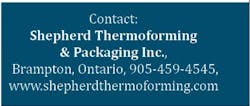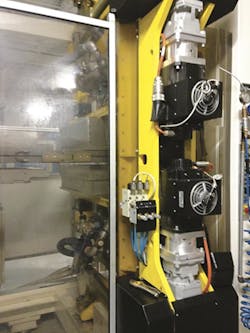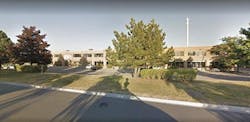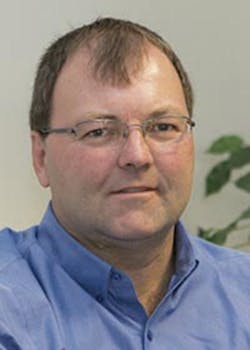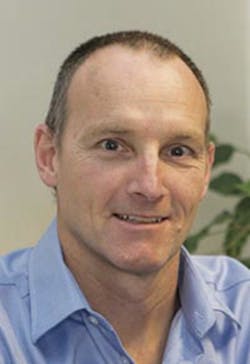Thermoformer taking swings at innovation
The Brampton, Ontario, company is under the day-to-day management of brothers Todd and Mark Shepherd, who, on the day of Plastics Machinery Magazine's visit, discussed several aspects of their business, including how to apply the single-minute-exchange-of-die (SMED) concept to thermoforming.
Think about a Formula 1 pit stop, meticulously choreographed for crews to pull off a perfect tire change in just a few seconds. It's an entirely different world than custom thermoforming, but such "pie-in-the-sky" comparisons are one way in which the brothers can get their team to start thinking about making big improvements in their thermoforming world.
"It's hard to convey it to people on the floor," President Todd Shepherd said. "I worked on the machines for a while. I'm always trying to figure out a way they can relate."
He showed his team a video of a pit crew where 20 guys complete the tire change in a few seconds.
"We're getting them to think about how it can be smoothed out," he said of the stages leading up to a tooling change. "When that machine finishes, all the bells and whistles are going to go off. You go down and do your part. The problem we have is the skilled part. How do you get enough people trained on those skills and pull it off? We need the skilled people there to do the fine-tuning, which generally is an hour, an hour and a half."
You may want to stay tuned: The company's engineers are working on it. As the Shepherds well know, in the fickle world of consumer packaging, timing is everything.
"They're designing the ways tools are going into machines and commonizing things," said Mark Shepherd, VP of finance, of the in-house engineering team. "We're even looking beyond the equipment that we have here now."
SWING-OUT form press
Shepherd constantly is evaluating its equipment and making sure it is performing as needed. Its latest workhorse is a thin-gauge, roll-fed, in-line thermoformer from OMG srl of Italy, which the company purchased as a result of requests for proposals made during NPE2015. It is a model from OMG's Elektra series, PVE 64-PN-M. Company officials visited roughly 12 thermoforming machinery makers during NPE, approaching each with customization parameters.
"After the show, I waited to see what feedback I would get," Todd Shepherd said. "I always want a machine and a builder that [are] flexible because I like to change things up. I'll want something added to it later. I won't always know what it is; I just know that I need that flexibility."
The machine is making PET mushroom packaging in a negative (female) form with a multicavity tool. The model has an especially attractive feature — a swing-out form press, which allows Shepherd's team to change out "bits and pieces" instead of the entire unit.
The forming press rotates out 180 degrees; the operator simply has to undo one bolt. When it comes to processing a material that requires plug assist, the swing-out mold uses third-motion dynamics, which allow for independent activation of the plug assist. Traditionally, the plug assist would be stationary within the pressure box.
Standard long-run tooling includes a full-form press "package," Todd Shepherd said. The basic package consists of a cooling base, forming mold, assist plug and a pressure box. In a traditional setup, this full package is pulled and replaced with the next package. On small runs, the full package may not be affordable, so Shepherd commonizes the cooling base and pressure box.
With the setup, these items can be left on the machine, allowing the technician the option of removing the mold and plug assist and exchanging them for the next tool's mold and plug assist. "Doing this requires getting access to difficult areas of the mold base and pressure box," Todd Shepherd said. "The swing-out form press makes this once-difficult or uncomfortable task easy and technician-friendly," he said.
Tooling changes represent the most time- consuming part of changing from one product line to another, the area on which Mark Shepherd has focused innovation over the next few years. The company is pondering various aspects of automation, perhaps even collaborative robots.
"We try to reduce set-up times," he said. "We really want to upgrade a lot of the old equipment. Ninety percent of the tooling that we have was built for the old lines; we're trying to be able to convert those to run on the OMG-type lines, so we can just get rid of the old equipment and not have an issue setting up, and in fact, take the average three-and-a-half-hour setup and reduce it to two and a half hours or one and a half hours."
The older equipment includes three in-line, hydraulic, thin-gauge machines. They date from the mid-1990s and early 2000s and will be phased out over the next several years.
"When we bought the OMG, we needed more capacity," Mark Shepherd said. "We bought the line with the idea of purging out the aging lines."Each line is equipped with a Rotogran grinder downstream, and a wall separates the grinders from the processing lines. The wall is necessary so that there is no cross-contamination. This is a feature that is even more critical as Shepherd serves more food packaging customers. It recently was awarded certification for manufacturing food-sector packaging materials through NSF Food Safety Certification LLC of Ann Arbor, Mich.
"You do not want those contaminants," Todd Shepherd said. "We needed the wall there to protect the regrind from coming back into the parts. We've got to keep debris to a minimum."
Through thick and thin
Shepherd is a bit unusual in the world of thermoforming. Besides its thin-gauge business, it also has two thick-gauge rotary thermoformers operating in a 7,500-square-foot area of its factory. Getting into this business was a means for the company to diversify.
"This is all we know," Todd Shepherd said of finding a way to protect his company against a downturn in the thin-gauge side of the business. "We bought a machine and started tinkering with heavy-gauge in case something went sideways. We found way more customers than we thought we were going to find."Todd Shepherd puts it bluntly about positioning his company for success in such a competitive marketplace: "Here in Canada, chances are if there is something that you need thermoformed, we can do it."
The company's Maac thermoformer is a three-station, 5-foot-by-10-foot machine with draw depth of up to 36 inches. It can make products such as hot tubs. The other thick-gauge machine is a Brown built in a 5-foot-by-7-foot configuration.
On the day of PMM's visit, it was forming a front bumper engine deflector for Chrysler.
"This part of the business is quite different," he said. "In thin-gauge, in-line, there are probably about four weeks of backlog of jobs to run. This is not the case in thick-gauge." Though one machine runs 24/5, the other machine is operated as needed.
Innovating forward
Shepherd lays out a capital budget each year, and a lot of how it will innovate depends on how it's maneuvering to meet market demands.
"We try to do things that nobody else wants to do," Todd Shepherd said. "I'm trying to figure out where to take the company in the future. We're trying to figure out what the customer wants. Ideally, and they won't tell you this, but what they really want is they want to order it today; have us make it tonight and ship it to them tomorrow. That way they're not on the hook for anything. They don't have to plan. That is the perfect world. So that is the ultimate challenge to figure out how to make that happen. That's the goal, to figure out how to get there."
Shepherd was at the forefront when the industry changed from PVC to PET packaging. At that time, it would quote customers in both materials, and some of the bigger players in converting would come to Shepherd to get a project started.
"They would want us to figure it out," Todd Shepherd said. Shepherd also has a keen eye to know when to back out. The company would leave a market if a competitor had developed a clear advantage through, for instance, the vertical integration of extrusion and thermoforming processes to create a certain product.
"We can't compete because they extrude too, so there is a point where we have to find the job that is in the middle," he said.
The latest material that Shepherd is tackling is polylactic acid (PLA), which has been around for many years but, for the
company, certain economics and material properties had to be worked out. Years ago, the material had to be purchased by the truckload based on contract demand; processors had to have a deal for five years to take a certain amount. On material properties, heat deflection has improved as well.
"The material properties have come a long way," Mark Shepherd said. "The heat-deflection temperature has gotten a lot better."
One other area in which the company is innovating is a concept called contour printing, which is also known as pre-print or distortion printing. It's an alternative to retail packaging with graphic inserts, labels or in-mold labeling. The concept requires only one raw material — sheet made from post-consumer recycled beverage bottles.Graphics are printed on the flat surface of the sheet and then the package is thermoformed into shape.
Angie DeRosa, managing editor
Just the facts
COMPANY: Shepherd Thermoforming & Packaging Inc.HEADQUARTERS: Brampton, OntarioOWNERS: The Shepherd familyTOP OFFICIAL: Todd Shepherd, presidentFOUNDED: 1985EMPLOYEES: 41LOCATION: BramptonANNUAL SALES: $7.1 million
